THE SAD TALE OF THE
BONUS MARCHERS
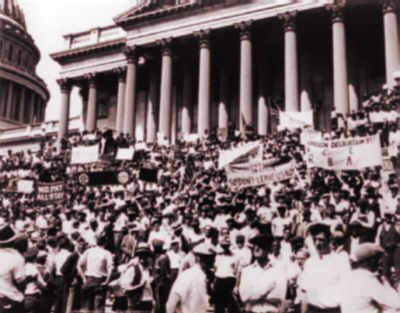
Bonus Marchers on the Capitol Steps
Following World War I, the U.S. federal government anticipated that its war-risk insurance plan would adequately protect American soldiers and sailors who had served during the war and that there would be no demand for compensation to those who had suffered no injury during their service in the army or navy. In 1924, however, Congress enacted a law, over the veto of President Calvin Coolidge, providing for a system of adjusted compensation based on length of service, with a distinction made in favor of service overseas. Under this plan, veterans entitled to receive $50 or less were to be paid in cash; those entitled to receive more than $50 were to receive certificates maturing in 20 years.
Veterans up to the rank of major with at least 60 days service each received a dollar for each day of domestic service up to $500 and $1.25 for each day of overseas service up to $625. The bond that each received in 1924 (in lieu of cash) would accumulate compound interest, resulting in an average payment of about $1,000 for each veteran in 1945. |
In order to meet full payment of these certificates when they matured in 1945, Congress provided that a trust fund be created through the appropriation of twenty annual installments of $112 million each. This would yield a total of $2.24 billion. Interest compounded annually would increase this sum approximately to the amount required to meet the face value of the certificates at maturity. By April 1932, there were 3,662,374 of those certificates outstanding, bearing an aggregate face value of $3.638 billion. By this time eight annual installments of $112 million had been paid into the fund by Congress, making a total of $896 million, and accrued interest had added $95 million, bringing the fund to $991 million.
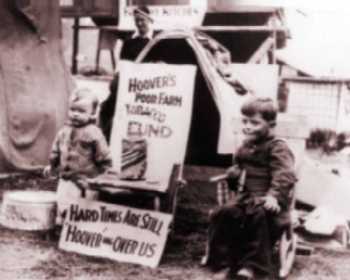
Children at the Marchers' "City"
However, because of the Great Depression, in 1931 Congress expanded the privilege of borrowing with an amendment adopted over the veto of President Herbert Hoover, increasing the loan value of the certificates from 22 1/2 per cent to 50 per cent of face value.
By April 1932, loans amounting to $1.248 billion were outstanding. The difference between this figure and the total face value of the certificates, $3.638 billion, was $2.390 billion. This was the additional sum which the veterans would receive if Congress, again over the President's veto, approved a new proposal for immediate redemption of the certificates at face value, 13 years before maturity in 1945.
This early redemption capability came to be referred to by members of Congress and veterans groups as a bonus, and during the early months of 1932 the bonus was a topic of ongoing discussion in the legislature. Because of the opposition of President Hoover and many senators and members of the House, due primarily to the fact that the country was trying to work its way out of the Depression and this action would put a severe strain on the federal budget, veterans groups began to organize around the country with the idea of marching on Washington, DC to press their demands.
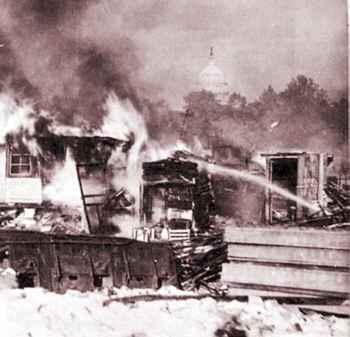
Marchers' Camp Burned
Beginning in May 1932, groups of World War I veterans began difficult journeys across the country, traveling in empty railroad freight cars, in the backs of trucks, in cars, on foot, and by any other means that became available. By mid-June it was estimated that as many as 20,000 veterans and some family members had arrived in Washington and were camping out, often in dirty, unsanitary conditions, in parks and military bases around the city, depending on donations of food from a variety of governments, churches, and private citizens. On 16 June, the House passed the bonus bill by a vote of 209–176, but on 18 June the Senate defeated the bill 62–18.
At this point, the federal and district governments began to make arrangements to force the veterans to go home, but very few accepted the offer, vowing to stay until they received their bonus. Throughout July the veterans, known as the Bonus Expeditionary Force, continued to hold marches and rallies despite the fact that they were receiving ultimatums to leave, with the White House proposing use of troops to force an evacuation.
Then, on 29 July 1932, troops did storm several buildings that the veterans were occupying as well as their main camp, setting tents on fire and forcing an evacuation. When it was over, one veteran had been killed and about 50 veterans and Washington police had been injured in various confrontations. Over the next several months, a much smaller group of Bonus Expeditionary Force members continued to pressure Congress, and in May 1933 about 1,000 veterans marched again on Washington. Newly elected President Franklin Roosevelt also opposed the bonus but demonstrated his concern for the unemployed veterans by issuing an executive order permitting the enrollment of 25,000 of them in the Civilian Conservation Corps for work in forests. When the veterans realized that President Roosevelt would also veto the bonus bill but was offering an alternative solution they gradually backed away from their demands, and the issue of the veterans' bonus eventually faded from the news.
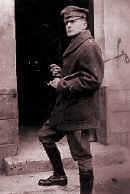 | 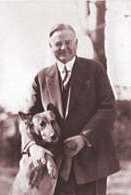 |
Chief of Staff Douglas MacArthur and President Herbert Hoover Suffered Irreversible Damage to Their Reputations After the Affair. | |
A footnote: The breakup of the Bonus Army in Washington was conducted by Army Chief of Staff and World War I veteran Douglas MacArthur, assisted by Majors George Patton and Dwight Eisenhower. MacArthur is considered to have exceeded President Hoover's intentions [and possibly his explicit instructions] with his heavy-handedness. MH

Perhaps it is that same curse of not supporting WWI veterans then, that we as nation, experience now. And why is that?
ReplyDeleteDid the Bonus Marchers receive their payments in 1945 as scheduled or not?
ReplyDelete